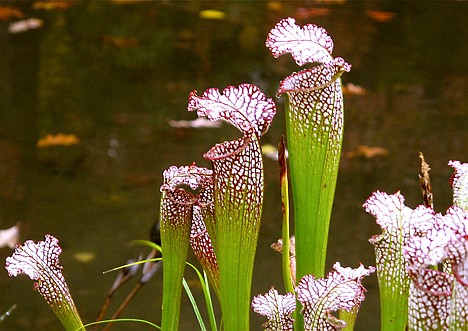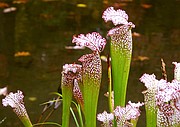Bog gardens add interest, biodiversity
Dean Fosdick | Hagadone News Network | UPDATED 15 years, 6 months AGO
Bog gardens are making a big splash with people wanting to create unusual pockets of interest near their homes. Few wetlands contain as many different life forms.
"The really cool thing about bogs is their plant diversity," said Robert Brzuszek, an associate professor specializing in landscape design and ecology at Mississippi State University.
Next to rain forests, sunny bogs in America's Southeast, which are characterized by insect-snaring pitcher plants, are the most bio-diverse settings in nature, he said, supporting as many as 75 different plants per square meter.
Bogs should not be confused with swamps (shallow pools of open water dominated by trees), marshes (flooded areas characterized by shrubs), ponds (bodies of water smaller than lakes) or rain gardens (planted parcels that absorb rainwater runoff).
"Bogs are basically wet meadows or depressions with a sphagnum peat layer as part of the substrate," Brzuszek said. "They're like a sheet of water passing slowly through the environment."
Why would anyone want to build an artificial bog garden?
Perhaps to make a naturally waterlogged area look more attractive, Brzuszek said.
"Some of the wet soil plants are not only showy, but they're educational," he said. "Lots of people have bog gardens just so they can grow carnivorous plants, generally pitcher plants. Children in particular are interested in plants that trap and devour insects."
Others want to invite wildlife that they wouldn't see in drier settings, such as dragonflies, tadpoles and turtles.
"Some insects are very specific about living in bogs and nowhere else. They're adapted to certain plants," Brzuszek said. "That attracts different birds to feed on them, so in the end you get wildlife diversity along with plant diversity."
Still other gardeners want to contribute to a cleaner environment.
"A lot of people don't set out to build a bog garden but end up with one because they're running water through the ground and need a (natural) filter," said Jason Blake, aka "The Pond Guy," a retailer of pond, lake and water garden supplies from Marine City, Mich. "Waste gets broken down in a bog. Plants use the waste as fertilizer. That results in clear water, healthy fish and vigorous plants."
If you're thinking about creating a bog, look for a sunny site, possibly in a roadside ditch, a saturated area bordering a pond or near an existing water fixture. A good soil blend is 80 percent coarse peat moss with 20 percent sand. "Peat retains moisture levels; sand opens it up a bit," Brzuszek said.
Bogs should be at least a foot deep so plant roots can develop. Lay a plastic pond liner on the bottom and punch a few holes in it to allow for drainage. Never let a bog dry out, but don't overdo the watering, either. Mosquitoes breed in stagnant pools.
The size of bog gardens vary, but they usually run larger than rain gardens. Consider planting in containers if you're starved for space. Use the same moss-sand mixture as for in-ground bogs. Containers should be at least 8 inches deep and a foot wide or they'll dry too easily, Brzuszek said.
Go native.
"My major concern is that people select the right plants - making sure they're not invasive," said Jack Whetstone, an extension aquaculture specialist with Clemson University. "Local nurseries are a good place to start, or look to your local extension service to see if they have a list."
Along with carnivorous varieties, think about including Jack-in-the-pulpit, irises, lobelias, milkweed, ferns, blueberries and cattails. All are perennials and grow well even in temperate climates.
Bogs are good to have in a neighborhood, Brzuszek said. "They're interesting and unusual and threatened as an ecosystem. Less than 10 percent of the pitcher plant bogs that once occurred in the Southeast are remaining."
On the Net:
• See this Mississippi State fact sheet about building bog gardens: http://msucares.com/lawn/landscape/sustainable/bog.html.
• You can contact Dean Fosdick at [email protected]
ARTICLES BY DEAN FOSDICK

`Sustainable gardening' includes many eco-friendly practices
``Sustainable” is one of gardening’s trendiest buzzwords, yet it carries a range of definitions. Just what does it mean in practical terms, and how important is it to the average gardener?

`Re-Wilding' your lawn takes work, especially at first
“Re-wilding” is the trend toward diversifying traditional lawns by putting in native plants that flower and fruit, boosting wildlife populations. It returns more control of the home landscape to nature.
Late-summer veggies can fill garden's void
Mid- to late summer is prime time for gardeners - a last chance to grow a second batch of fresh vegetables before the plant-killing frosts arrive. Add a few protective enclosures, such as cold frames, overhead sheets and hoops, and the harvest can be extended until Thanksgiving and beyond.



